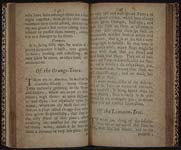Hughes, William.
The American Physitian; Or, a Treatise of the Roots, Plants, Trees, Shrubs, Fruit, Herbs, &C. Growing in the English Plantations in America . . .Whereunto is Added a Discourse of the Cacao-Nut-Tree, And the Use of Its Fruit; With All the Ways of Making of Chocolate. The Like Never Extant Before. London: Printed by J. C. for William Crook . . ., 1672. 159 pp. plus [5]pp. of advertisements. This work is bound in modern crimson gilt calf, spine gilt extra and gilt inner dentelles.




This text is one of the first English books on the horticulture of the New World, written in the West Indies not long after England's acquisition of Jamaica in 1655 and the establishment of settlements in Barbados and other islands. Substantial portions of the text are devoted to chocolate, cane sugar and cotton, all new products which aroused the scientific, medical and commercial curiosity of European readers. Hughes describes many tropical fruits and plants familiar to Florida, including the lemon tree, orange tree and mangrove tree. The author dedicates over fifty pages to the "cacao-tree and fruit." He describes ways to make chocolate, the planting and harvesting of the plant, and a chapter on the "vertues of the Drink called Chocolate." He describes these trees as not very tall or big in bulk, with roots that "Grow together strangely confused all along the banks by the Sea side, joyning a wonderful contexture, without any intermission, for a mile or two." Hughes explains that this tree is often called the Oyster Tree due to the oysters that attach and grow amongst the roots. "The Oysters that grow thereon are good aliment, nourishing, and stirring up bodily lust; but they are something more loathsome and sweet, than our Oysters are; so that very many at once are seldom eaten, by which surfeits are avoided." At the beginning of the book is an alphabetical list of the contents of the book, alphabetized by plant names. A short poem by "H.E." follows the preface of the book:
"On Mr. Hughes Treatise of American Plants"
The world of Treatises hath had great store,
But such an one was never seen before:
What here's disclos'd, Columbus did not see
In his American discoverie.
He to find out the Land did boldly venture;
But Hughes I'th' bowels of the Land did enter,
To Find the Roots of Plants, and rarer things,
To profitSubjects, and to please their Kings. (Ray,
Our Lovel, Gerrard Johnson, and learn'd
Did travel far in the Botanick way:
But this our Author hath out-went them clear,
As by the following lines it doth appear:
In which the Plants of India may be found,
And their Vertues, to keep our Bodies found.
H.E.
Little is known of Hughes beyond the fact that he once worked in Warwickshire for the mother of Viscount Conway. He is the author of two other horticultural works, The Compleat Vineyard (1665) and The Flower-Garden (1671). A long address to the reader herein emphasizes that this book was not written "in closet or study, in the corner of a house, amongst many books; but... rather in travelling the woods, and other parts." Hughes seems to have spent most of his time in Jamaica, though he makes allusions to other islands. The book concludes with a five page catalogue advertising books printed for William Crook.